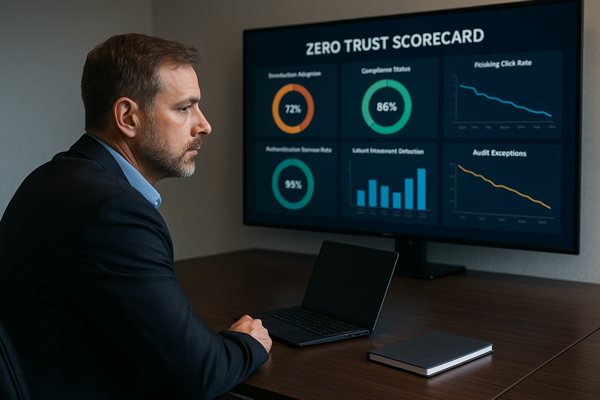How identity became the new perimeter
In 2025, identity is no longer simply a control at the edge of your network — it is the perimeter. As organizations adopt SaaS‑first strategies, hybrid work, remote access, and cloud identity federation, the traditional notion of network perimeter has collapsed. What remains is the identity layer — and attackers know it.
Today’s breaches often don’t involve malware, brute‑force password cracking, or noisy exploits. Instead, adversaries leverage stolen tokens, hijacked sessions, and compromised identity‑provider (IdP) infrastructure — all while appearing as legitimate users.

That shift makes identity security not just another checkbox — but the foundation of enterprise defense.
Failure points of modern identity stacks
Even organizations that have deployed defenses like multi‑factor authentication (MFA), single sign‑on (SSO), and conditional access policies often remain vulnerable. Why? Because many identity architectures are:
-
Overly permissive — long‑lived tokens, excessive scopes, and flat permissioning.
-
Fragmented — identity data is scattered across IdPs, directories, cloud apps, and shadow IT.
-
Blind to session risk — session tokens are often unmonitored, allowing token theft and session hijacking to go unnoticed.
-
Incompatible with modern infrastructure — legacy IAMs often can’t handle dynamic, cloud-native, or hybrid environments.
In short: you can check off MFA, SSO, and PAM, and still be wide open to identity‑based compromise.
Token‑based attack: A walkthrough
Consider this realistic scenario:
-
An employee logs in using SSO. The browser receives a token (OAuth or session cookie).
-
A phishing attack — or adversary-in-the-middle (AiTM) — captures that token after the user completes MFA.
-
The attacker imports the token into their browser and now impersonates the user — bypassing MFA.
-
The attacker explores internal SaaS tools, installs backdoor OAuth apps, and escalates privileges — all without tripping alarms.
A single stolen token can unlock everything.
Building identity security from first principles
The modern identity stack must be redesigned around the realities of today’s attacks:
-
Identity is the perimeter — access should flow through hardened, monitored, and policy-enforced IdPs.
-
Session analytics is a must — don’t just authenticate at login. Monitor behavior continuously throughout the session.
-
Token lifecycle control — enforce short token lifetimes, minimize scopes, and revoke unused sessions immediately.
-
Unify the view — consolidate visibility across all human and machine identities, across SaaS and cloud.
How to secure identity for SaaS-first orgs
For SaaS-heavy and hybrid-cloud organizations, these practices are key:
-
Use a secure, enterprise-grade IdP
-
Implement phishing-resistant MFA (e.g., hardware keys, passkeys)
-
Enforce context-aware access policies
-
Monitor and analyze every identity session in real time
-
Treat machine identities as equal in risk and value to human users
Blueprint: continuous identity hygiene
Use systems thinking to model identity as an interconnected ecosystem:
-
Pareto principle — 20% of misconfigurations lead to 80% of breaches.
-
Inversion — map how you would attack your identity infrastructure.
-
Compounding — small permissions or weak tokens can escalate rapidly.
Core practices:
-
Short-lived tokens and ephemeral access
-
Just-in-time and least privilege permissions
-
Session monitoring and token revocation pipelines
-
OAuth and SSO app inventory and control
-
Unified identity visibility across environments
30‑Day Identity Rationalization Action Plan
| Day | Action |
|---|---|
| 1–3 | Inventory all identities — human, machine, and service. |
| 4–7 | Harden your IdP; audit key management. |
| 8–14 | Enforce phishing-resistant MFA organization-wide. |
| 15–18 | Apply risk-based access policies. |
| 19–22 | Revoke stale or long-lived tokens. |
| 23–26 | Deploy session monitoring and anomaly detection. |
| 27–30 | Audit and rationalize privileges and unused accounts. |
More Information
If you’re unsure where to start, ask these questions:
-
How many active OAuth grants are in our environment?
-
Are we monitoring session behavior after login?
-
When was the last identity privilege audit performed?
-
Can we detect token theft in real time?
If any of those are difficult to answer — you’re not alone. Most organizations aren’t architected to handle identity as the new perimeter. But the gap between today’s risks and tomorrow’s solutions is closing fast — and the time to address it is now.
Help from MicroSolved, Inc.
At MicroSolved, Inc., we’ve helped organizations evolve their identity security models for more than 30 years. Our experts can:
-
Audit your current identity architecture and token hygiene
-
Map identity-related escalation paths
-
Deploy behavioral identity monitoring and continuous session analytics
-
Coach your team on modern IAM design principles
-
Build a 90-day roadmap for secure, unified identity operations
Let’s work together to harden identity before it becomes your organization’s softest target. Contact us at microsolved.com to start your identity security assessment.
References
-
BankInfoSecurity – “Identity Under Siege: Enterprises Are Feeling It”
-
SecurityReviewMag – “Identity Security in 2025”
-
CyberArk – “Lurking Threats in Post-Authentication Sessions”
-
Kaseya – “What Is Token Theft?”
-
CrowdStrike – “Identity Attacks in the Wild”
-
Wing Security – “How to Minimize Identity-Based Attacks in SaaS”
-
SentinelOne – “Identity Provider Security”
-
Thales Group – “What Is Identity Security?”
-
System4u – “Identity Security in 2025: What’s Evolving?”
-
DoControl – “How to Stop Compromised Account Attacks in SaaS”
* AI tools were used as a research assistant for this content, but human moderation and writing are also included. The included images are AI-generated.



